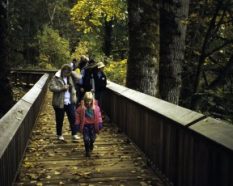Nature May Nurture Paying Attention
A green environment can help kids with attention disorders concentrate.
By Emily Sohn
Some kids have trouble sitting still, paying attention, or focusing on one task at a time. Those kids who often suffer such problems may have attention deficit hyperactivity disorder (ADHD), which can make classroom learning tough.
A new study offers a helpful suggestion for these kids: Go for a nature walk.
 |
|
A walk in the woods can help kids cope with attention disorders. |
| U.S. Fish and Wildlife Service |
Researchers from the University of Illinois at Urbana-Champaign gave a questionnaire to parents of children with ADHD. The questions focused on how the kids respond to various extracurricular activities in different settings. Choices for settings included leafy backyards, indoor playrooms, and city playgrounds. A group of 452 people completed the survey over the Internet.
The results of the questionnaire showed that the kids were more focused and paid better attention when they were in “green” outdoor environments than when they were in others. It didn’t matter how many other kids they played with or even if they played alone.
To really get at the effects of the environment, the researchers analyzed only activities that could be done anywhere. They didn’t include watching TV, for example, because that only happens indoors. And hiking is limited to the outdoors, so that didn’t count either. This analysis produced similar results.
The findings reinforce the idea that the environment, on its own, influences attention skills, the researchers say, regardless of the activity.
In yet another study, a group of kids with ADHD took a 20-minute guided walk on a nature trail. Another group took a 20-minuted guided walk on a city path. At the end of the walk, kids in the nature group scored better on attention tests than kids in the city group.
The studies didn’t look at kids without ADHD. Still, the advice might hold for everyone. If you find yourself dozing off or getting distracted while doing your homework, get out and walk in the woods for a few minutes. Make sure you come back, though. You still have to do the work sometime!—E. Sohn
Going Deeper:
Harder, Ben. 2004. Nature reduces kids’ signs of attention disorder. Science News 166(Sept. 18):190. Available at http://www.sciencenews.org/articles/20040918/note16.asp .
Sohn, Emily. 2004. Roller coaster thrills. Science News for Kids (June 16). Available at http://www.sciencenewsforkids.org/articles/20040616/Feature1.asp .
______. 2004. What video games can teach us. Science News for Kids (Jan. 21). Available at http://www.sciencenewsforkids.org/articles/20040121/Feature1.asp .
______. 2003. Brain signals attention disorder. Science News for Kids (Dec. 3). Available at http://www.sciencenewsforkids.org/articles/20031203/Note2.asp .
______. 2003. A classroom of the mind. Science News for Kids (Oct. 22). Available at http://www.sciencenewsforkids.org/articles/20031022/Feature1.asp .
Information for kids about attention disorders can be found at the Attention Deficit Disorder Association’s “Kid’s Area” at www.add.org/content/kids1.htm (Attention Deficit Disorder Association).







